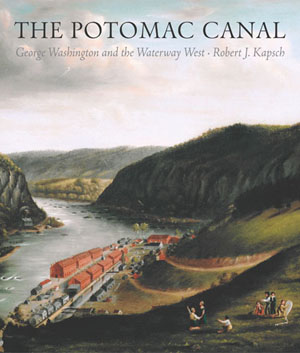Summary
2008 Recognition of Excellence, AIGA 50 Books/50 Covers Competition
2007 ForeWord Magazine Finalist in History
2007 ForeWord Magazine Silver Winner in History
2007 Winner, AIGA 50 Books/50 Covers Competition
2008 Washington Book Publishers Book Design and Effectiveness Second Place Award, Illustrated Cover or Jacket and Illustrated Text
The Potomac Canal: George Washington and the Waterway West is a history of a new nation’s first effort to link the rich western agricultural lands with the coastal port cities of the east. The Potomac Canal Company was founded in 1785, and was active until it was overtaken by the Chesapeake and Ohio Canal Company in 1828. During its operation, the canal system was used to ship flour from mills in the foothills of Appalachia to the tidewater of the Chesapeake, where the flour was shipped to the Caribbean as trade for sugar and other goods. This trade soon became the basis of agricultural wealth in West Virginia’s eastern panhandle and throughout the Appalachian Piedmont. Coal was also shipped via the canal system from the upper reaches of the Potomac River to workshops at Harpers Ferry and beyond. This industrial trade route laid the foundation for what would eventually become the Chesapeake and Ohio Canal and the Baltimore and Ohio Railroad.
Contents
- Chapter 1 - Early Proposals for a Potomac River Navigation · 1754-1775
- Chapter 2 - George Washington and the Early Development of the Potomac River
Navigation · 1784-1790 - Chapter 3 - Building the Little Falls and Great Falls Bypass Canals · 1791-1802
- Chapter 4 - The Shenandoah River Navigation · 1790-1890
- Chapter 5 - Other Canals of the Potomac River Basin · 1802-1828
- Chapter 6 - Workers of the Potomac Company · 1785-1828
- Chapter 7 - Operating the Potomac River Navigation · 1802-1828
- Chapter 8 - Maintaining the Potomac River Navigation · 1810-1828
- Chapter 9 - The Demise of the Potomac River Company · 1820-1828
- Endnotes
- Bibliography
- Index
Author
Robert J. Kapsch, PhD, Hon. AIA, ASCE, holds doctorates in American studies, engineering, and architecture, as well as master’s degrees in historic preservation and management. For fifteen years, Dr. Kapsch was chief of the Historic American Buildings Survey/Historic American Engineering Record, the U.S. government’s premier documentation program. He is the author of several books on historic architecture and engineering, including Canals, an illustrated history of American canals.
Reviews
"This beautiful coffee-table book with a plethora of full-color illustrations tells this story with academic acumen, aesthetic acuity, and great vitality."
George Brosi, Appalachian Heritage
"This new volume is a beautiful book, but it is so much more. . . .I recommend his work as a most reliable place to start understanding the Potomac project or early canals in general."
John Lauritz Larson, The Journal of Southern History
"Here it is at long last: the definitive work on what the National Park Service and the 1803 company logo call the Patowmack Canal. . . .It fills a serious gap in the history of American canals and should be of interest to social, political, business, and labor historians; historians of technology; industrial archaeologists; and those interested in the Early Republic."
John Austen, The Journal of the Society for Industrial Archeology
"Beautifully illustrated with architectural drawings of the canal and numerous paintings of the surrounding countryside, Kapsch's book serves as a rich source of primary material on both the early history of canal building in America and the Potomac River valley."
August Nigro, West Virginia History: A Journal of Regional History














